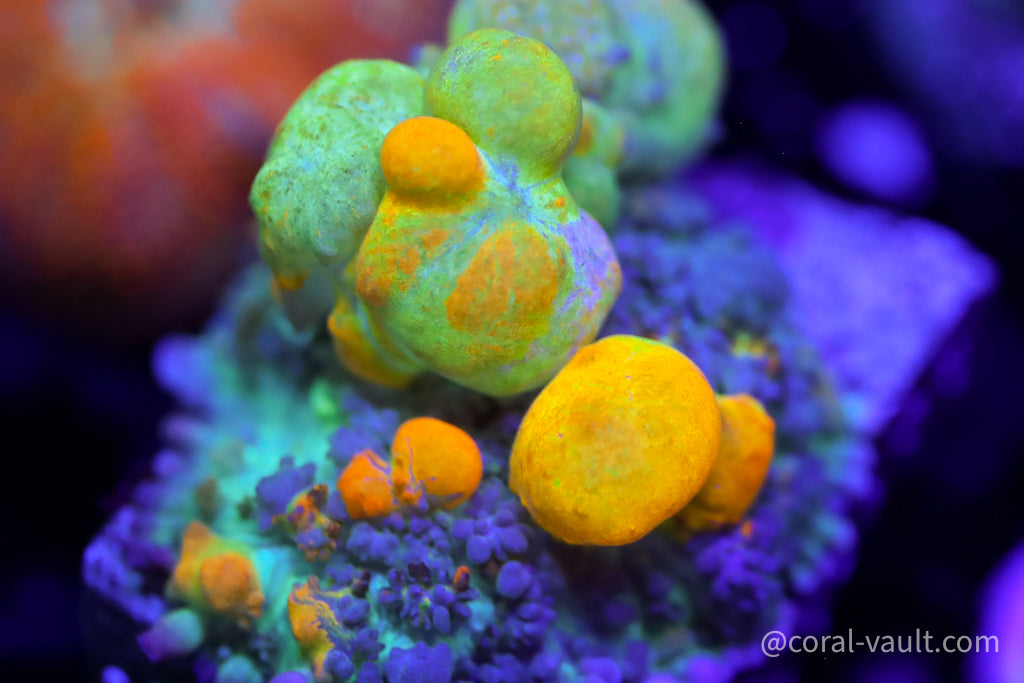
OG
Bounce Mushroom
one of the most sought after mushrooms in the indusrty
Considered a soft coral, “mushrooms” are a type of coral that can attract both beginning and experienced reefers. Some mushrooms are hardy and can take over a tank, while others are considered designer and are very slow growing. There are three groups of mushrooms commonly available on the market- Ricordea, Discosoma, and Rhodactis. The care needed to keep them alive is limited and they tend to thrive in all types of tanks. Mushrooms can be found all around the world, from Florida to the Indo-Pacific, but due to their prolific nature and the ease to which they can be propagated, they are a commonly aquacultured species, especially among hobbyists. They will thrive in a variety of light and flow conditions and are very forgiving. They contain symbiotic algae called zooxanthallae that provide them with a food source, but they can also be fed with a variety of foods from pellets to meaty foods and even powdered coral food. Prior to adding them to a tank, make sure to dip them so there are no unwanted pests being introduced to the tank. After they are dipped, drip acclimate them to allow them to get used to the aquarium’s water parameters. As they do produce mucus, mushrooms should be handled with care, making sure not to touch eyes, mouth, or any other sensitive body parts as they can cause allergic reactions, in both humans and household pets.
This genus of mushrooms contains 2 species- the Ricordea yuma and Ricordea florida. Both of these species are bottom dwelling and are sometimes referred to as flower mushroom corals or disc anemones. The Yuma Mushrooms are native to the Indo-Pacific, while the Florida Ricordea are native to the Caribbean, but aquacultured varieties are available. These mushrooms both have unique, small, rounded tentacles and come in a rainbow of colors. Ricordeas should be placed in areas of low flow, but where they will have moderate to intense light. However the art of placing them in a tank can be difficult as they have the ability to release their foot and float around, selecting locations on their own. This soft coral contains zooxanthallae that provides nutrients for it, but its diet can be supplemented with phytoplankton and other available coral foods on the market.. It is recommended to let them settle out on bits of rubble first and then place them in the tank. They will need to be dipped and drip acclimated before being added to any aquarium.


are one of the hardiest and most forgiving mushrooms available. They can be found in solid colors, spots, and stripes, some, like the Jawbreaker, are highly sought after. These mushrooms are native to the Indo-Pacific and are also popularly propagated by hobbyists. When placing these coral in the tank, keep in mind,they tend to thrive in lower lighting and lower flow. One unique thing about this group is that as they move around, they often leave behind part of their foot. From the material that is left behind, a new mushroom will grow. Because of this it doesn’t take much for a tank to quickly develop a sizable population of mushrooms. They contain a symbiotic algae that provides them with nutrients but they can be fed with phytoplankton or coral food. Before adding them to any tank make sure that they are dipped, and then acclimated. If irritated mushrooms produce a slime or a mucus that makes them hard to handle.
are a diverse group of mushrooms that are loved by beginners and advanced hobbyists alike. They come in a variety of colors and sizes and some of the species, like the Bounce mushroom with their brightly colored bubbles are one of the most popular species on the market. They are native to the Indo-Pacific. When placing them in an aquarium, they should be placed in an area where they will experience moderate light and flow. It should be noted that they are able to release their foot and move around the tank, settling where they feel best. They contain a symbiotic algae that provides them with a source of food, but they will also feed on a variety of foods placed in the tank such as phytoplankton, or coral food. Before adding a mushroom to the tank make sure to dip it and then acclimate it. As a note, when mushrooms are irritated they can produce a mucus that makes them difficult to hold.


